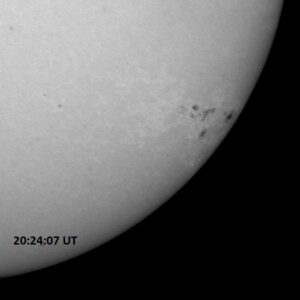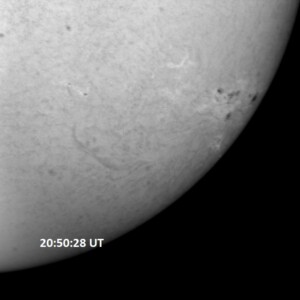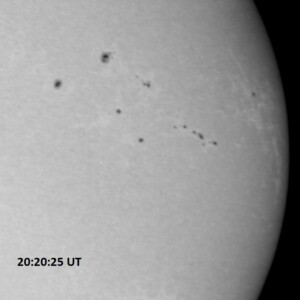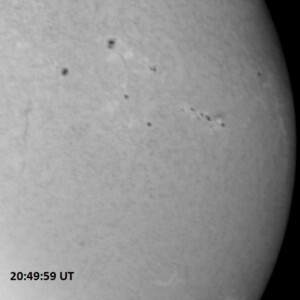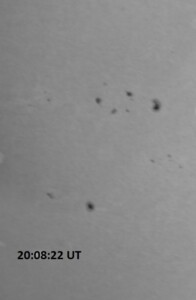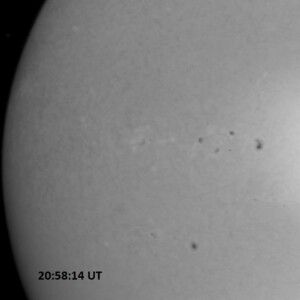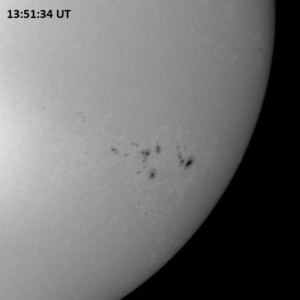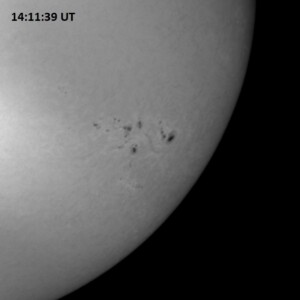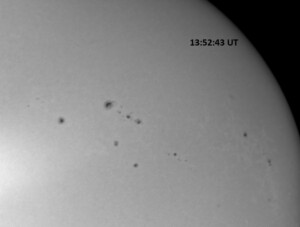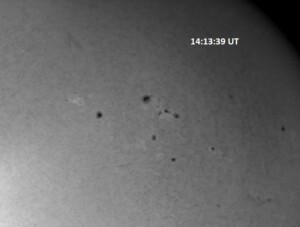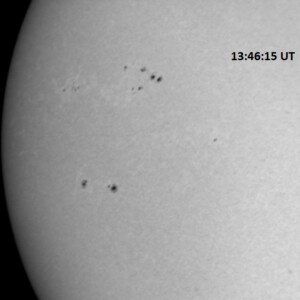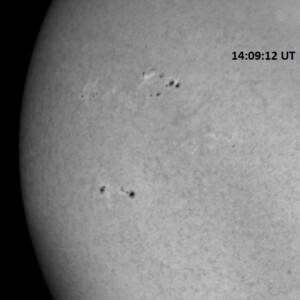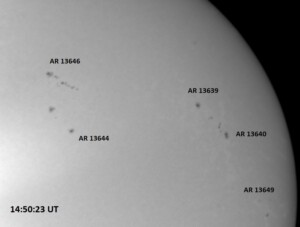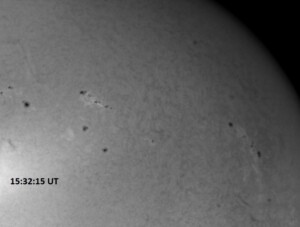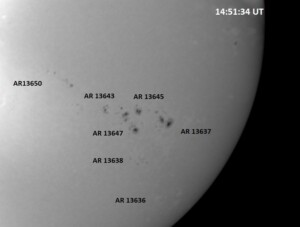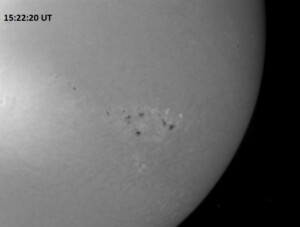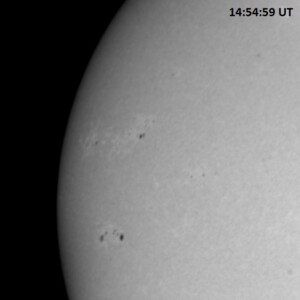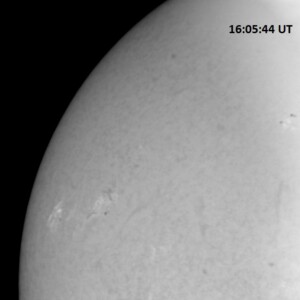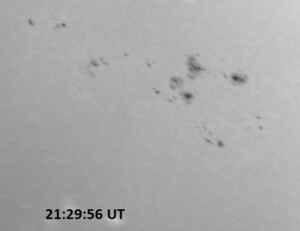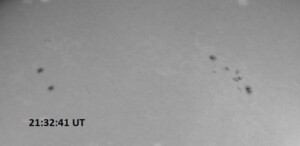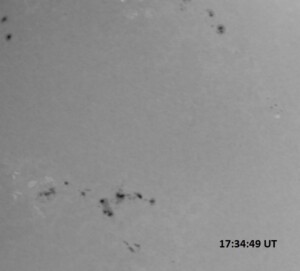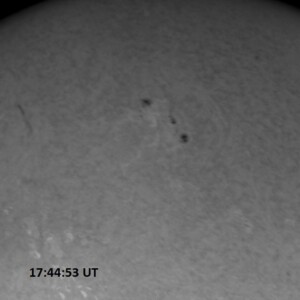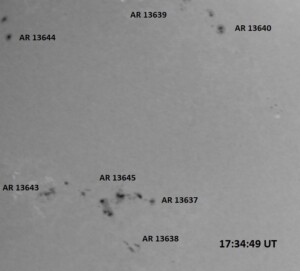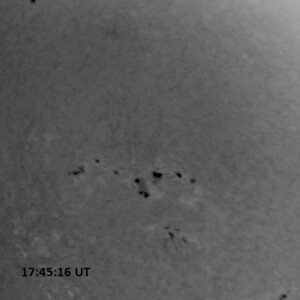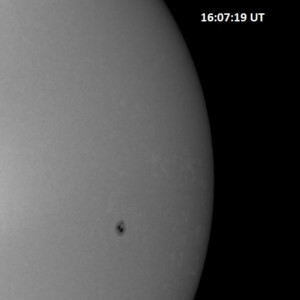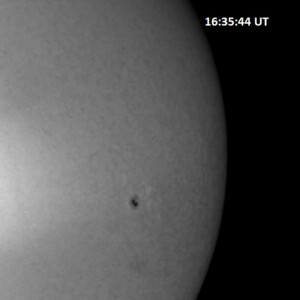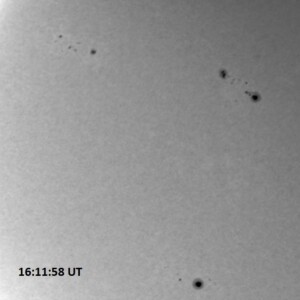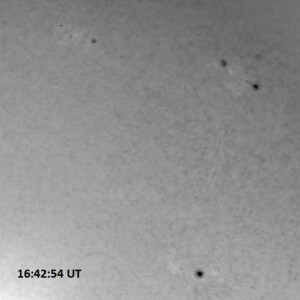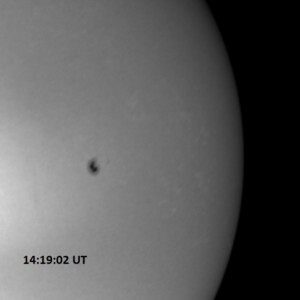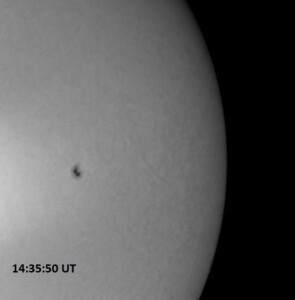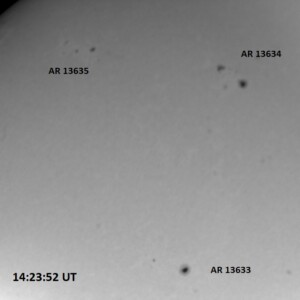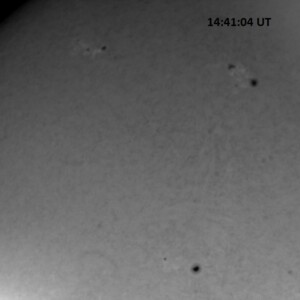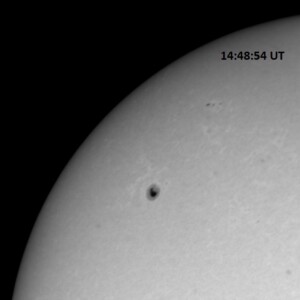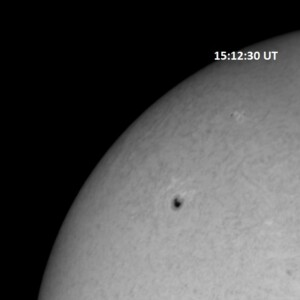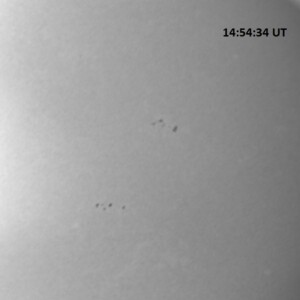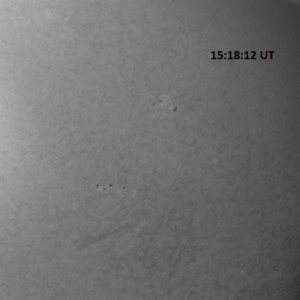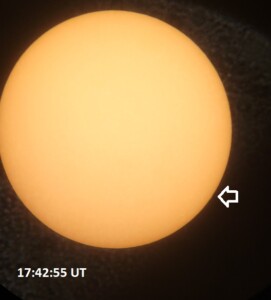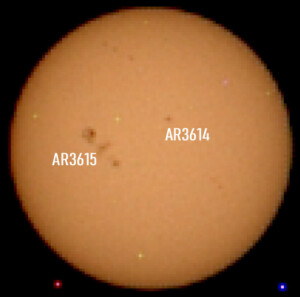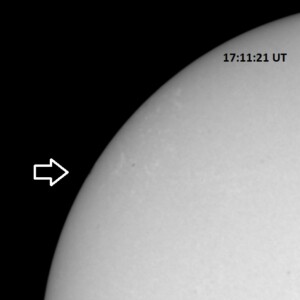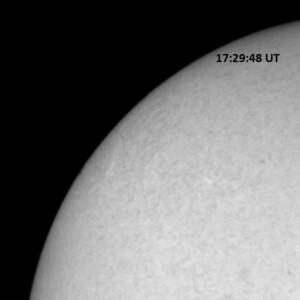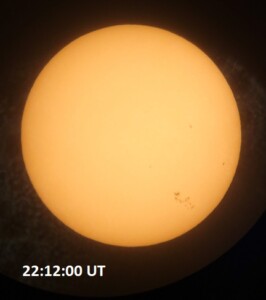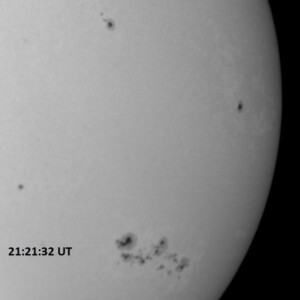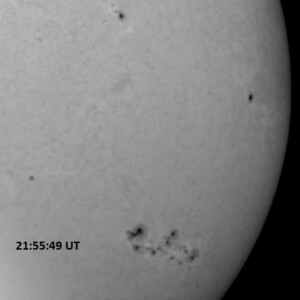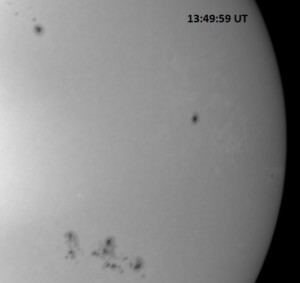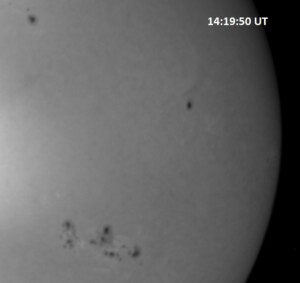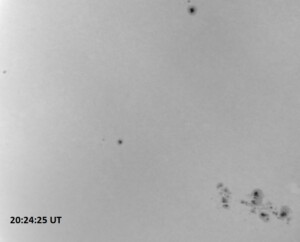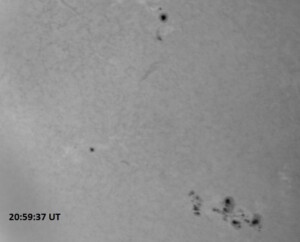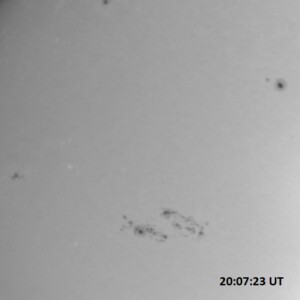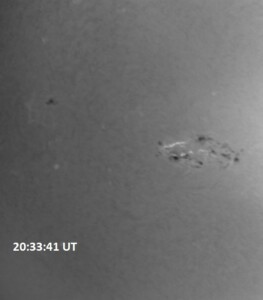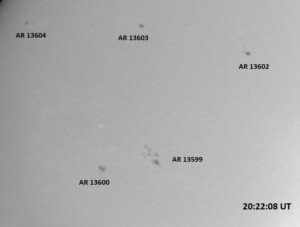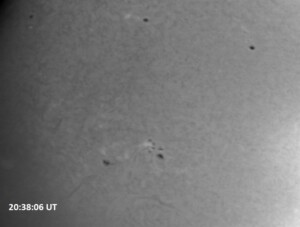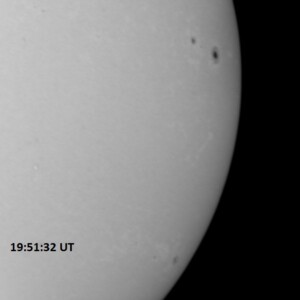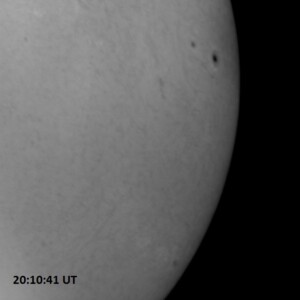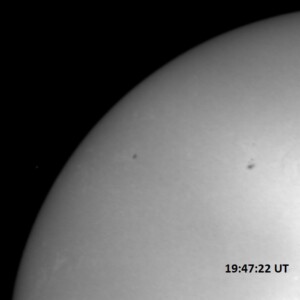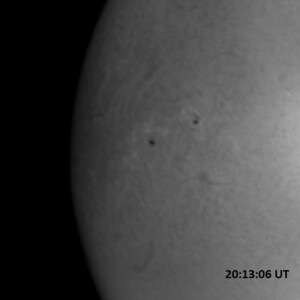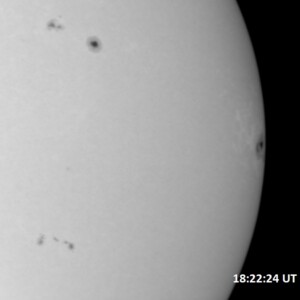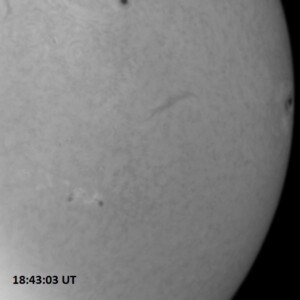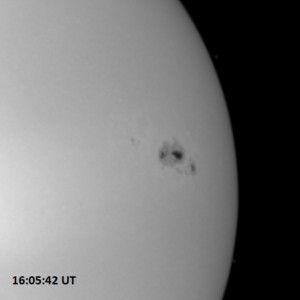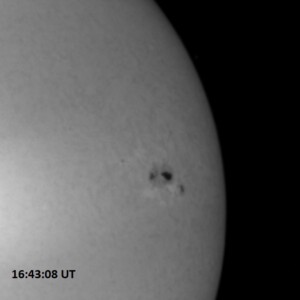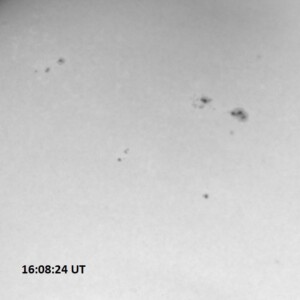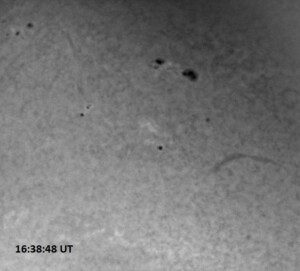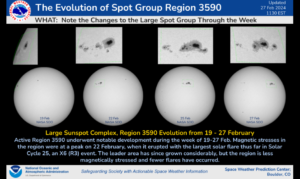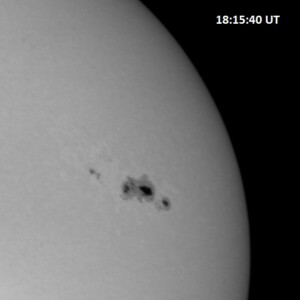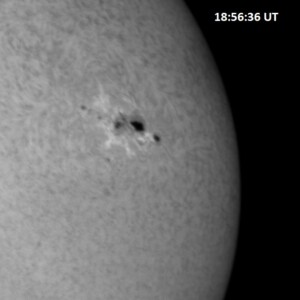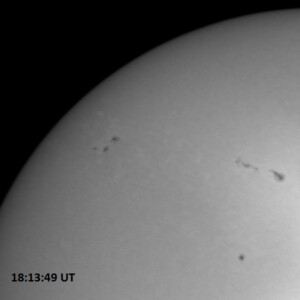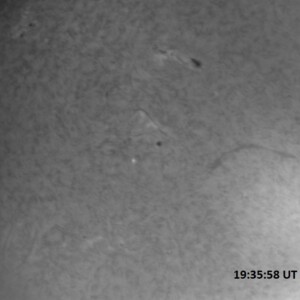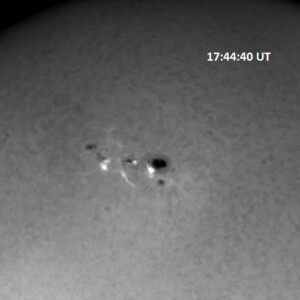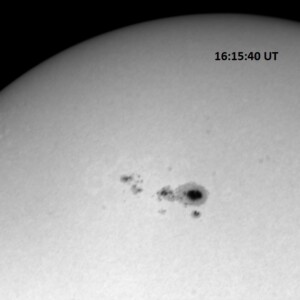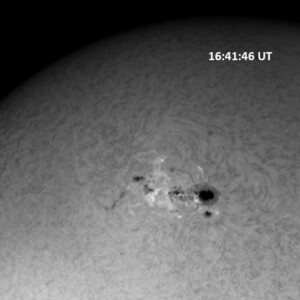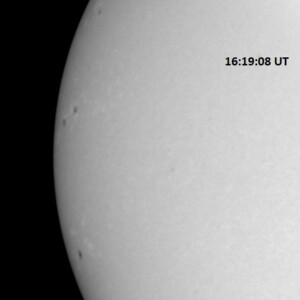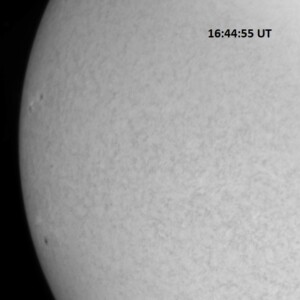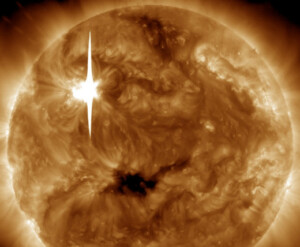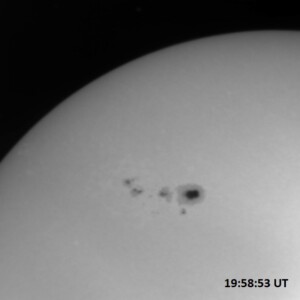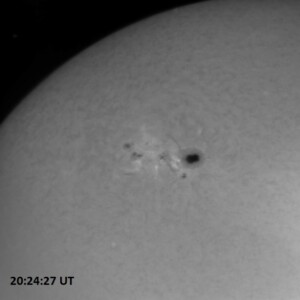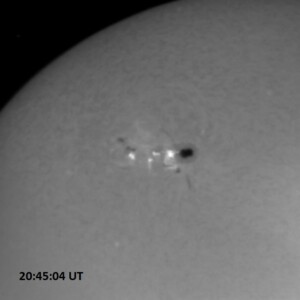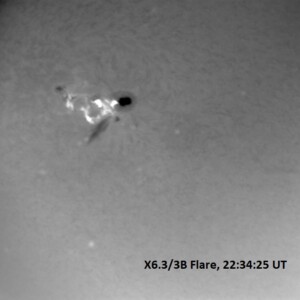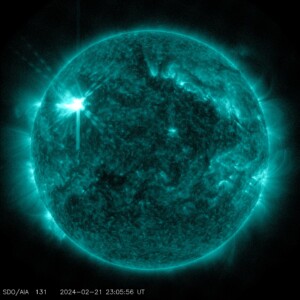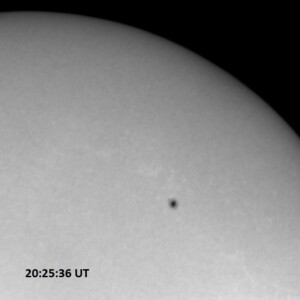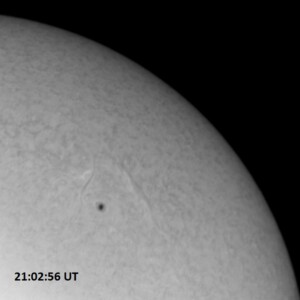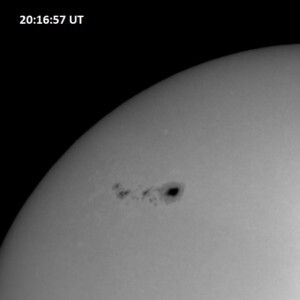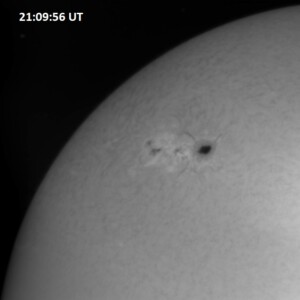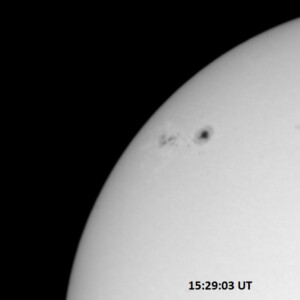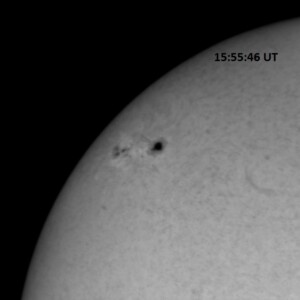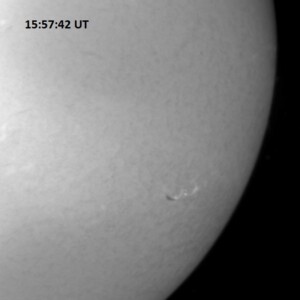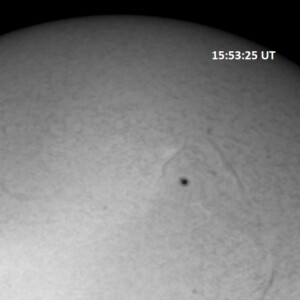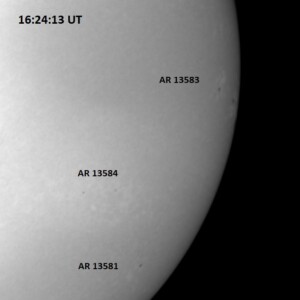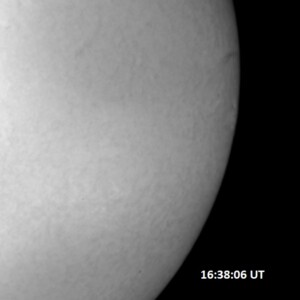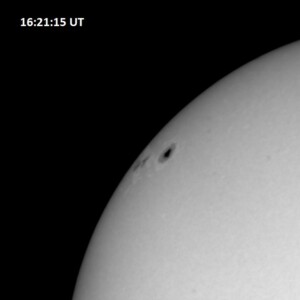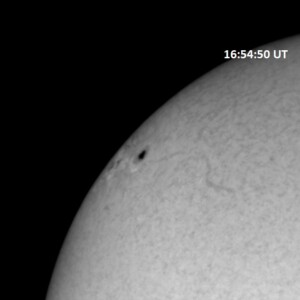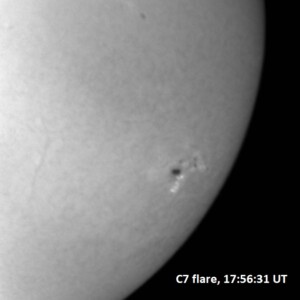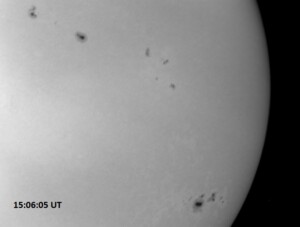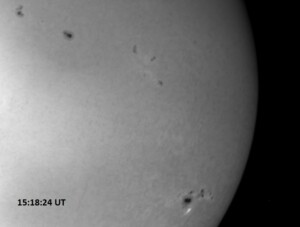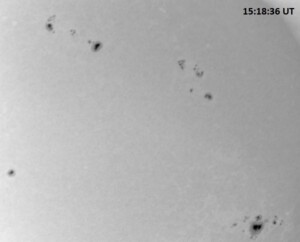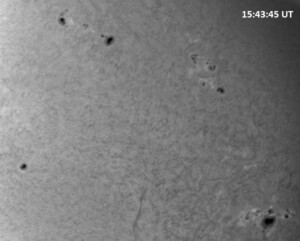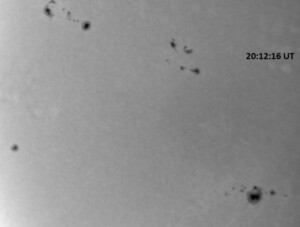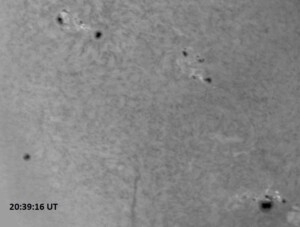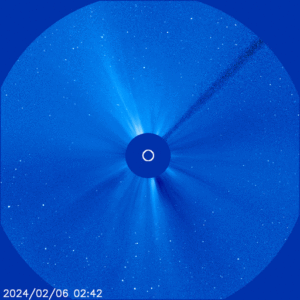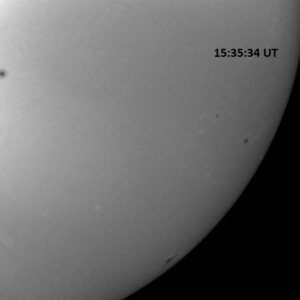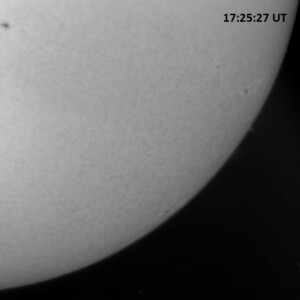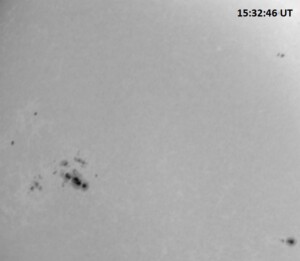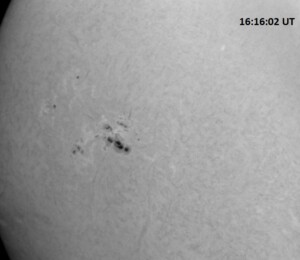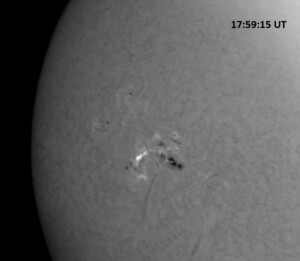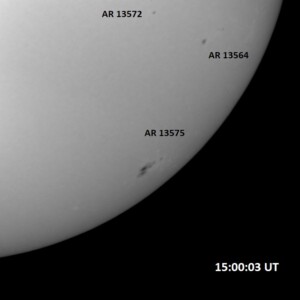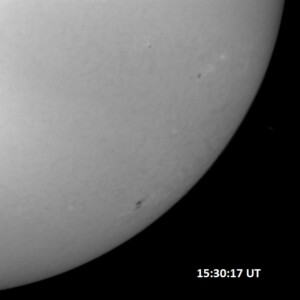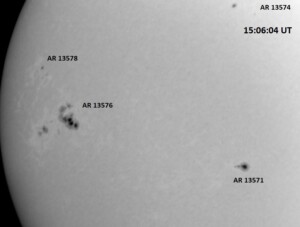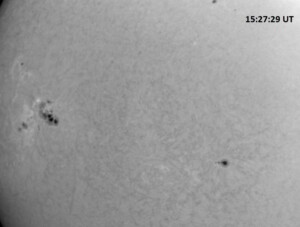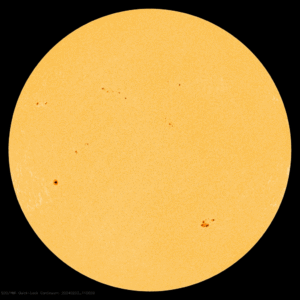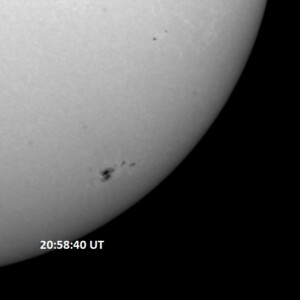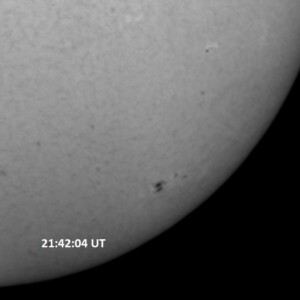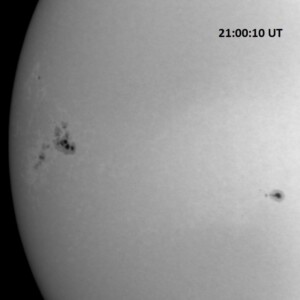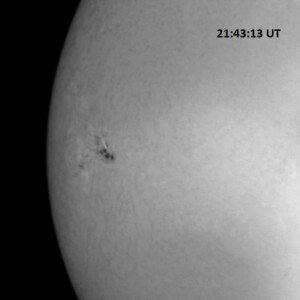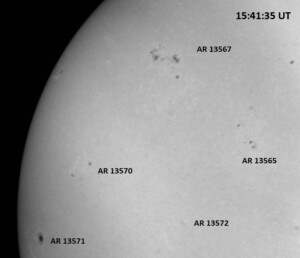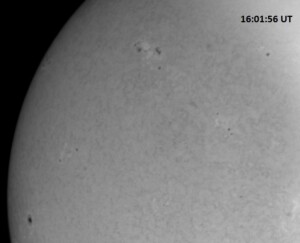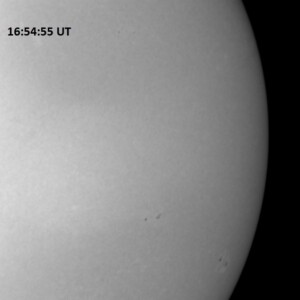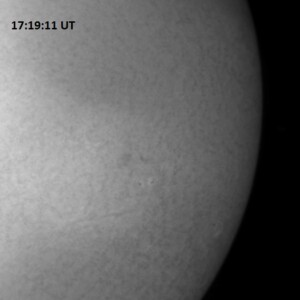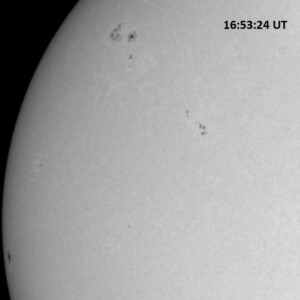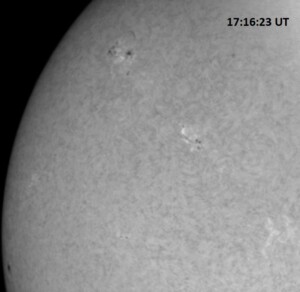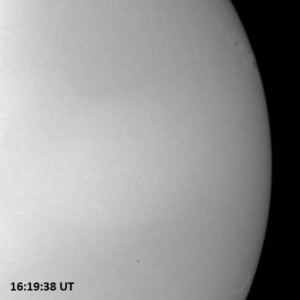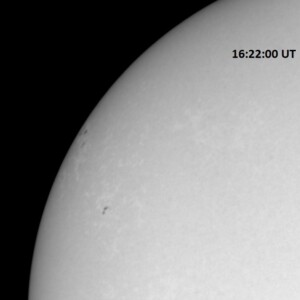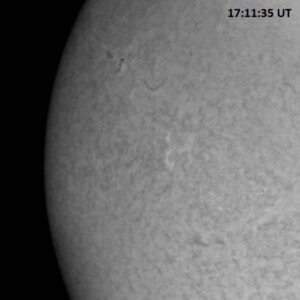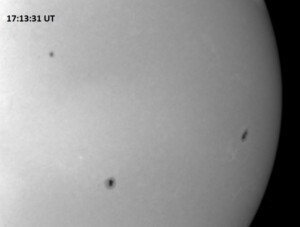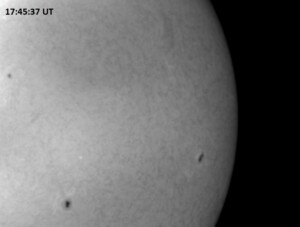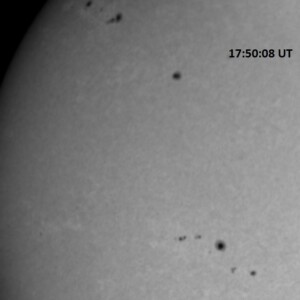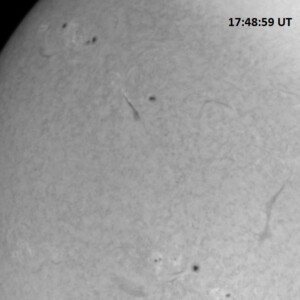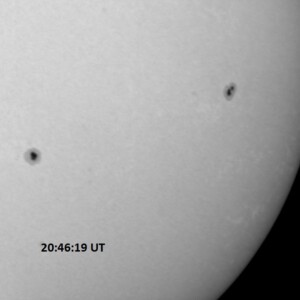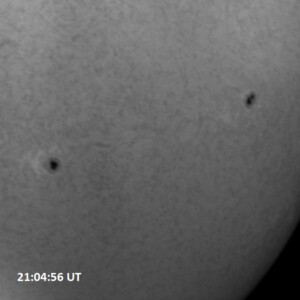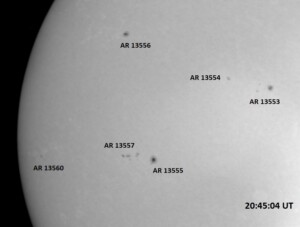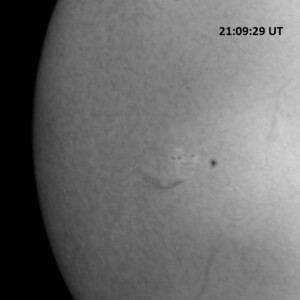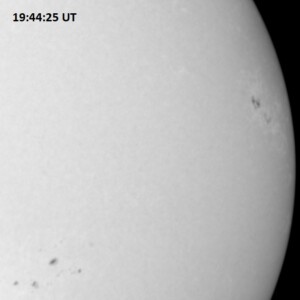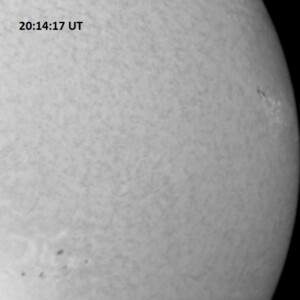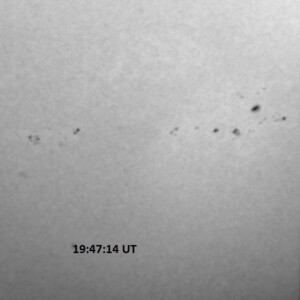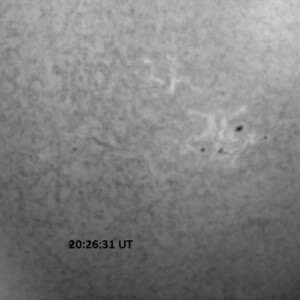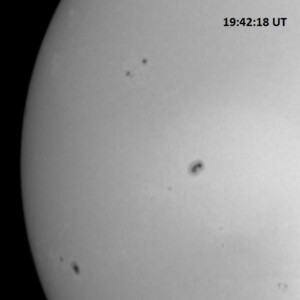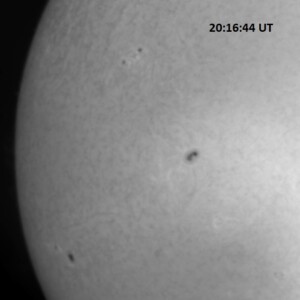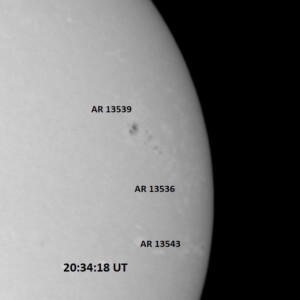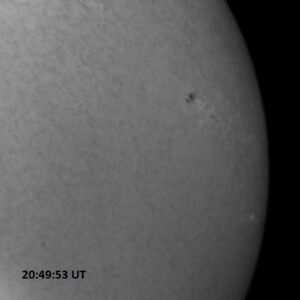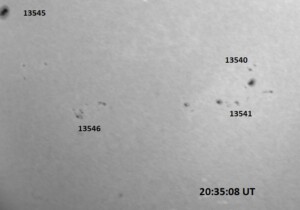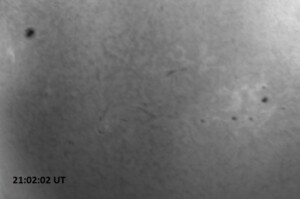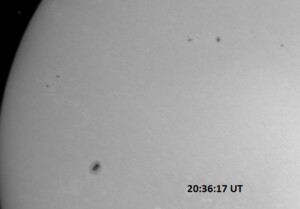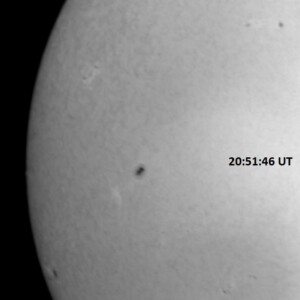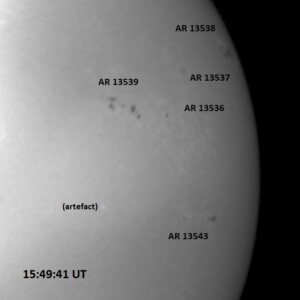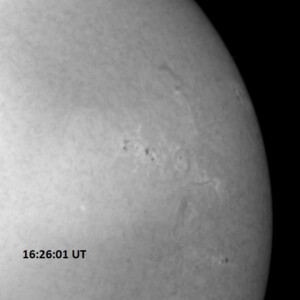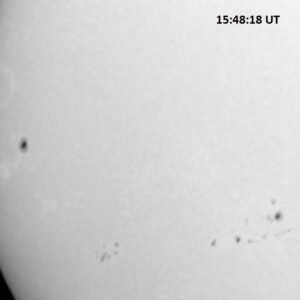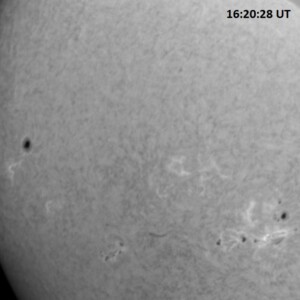The Latest Solar Images
Note: All images on this website © 2018-2024 by Brian Cudnik and Prairie View A&M Physics. All rights reserved.
Observations are happening daily, except for most Saturdays, all Sundays, and holiday periods; and are governed by duty schedule, weather, and solar activity. When the Sun has very low activity (spotless), observations will be limited or non-existent. Whenever the Sun becomes active again, the observing program will become active as well, weather permitting. The Sun is expected to reach the maximum activity level of the current Cycle 25 solar cycle. So we anticipate more events in terms of active region size and number, and solar flares.
One can monitor the Sun via several websites that provide real-time images of the Sun. The website, https://www.solarmonitor.org/, has such images in six different channels. The numbers are the NOAA designations for active regions (with the “1” at the start of the designation removed for convenience). Another website with up-t0-date information on solar activity and other goings-on in the skies is www.spaceweather.com. Additional information about the Sun’s current activity can be obtained from https://www.swpc.noaa.gov/, and real-time full-disk H-alpha images from observatories around the world can be viewed at http://halpha.nso.edu/.
A typical observing run may last from one to four hours, depending on seeing considerations, weather, and other work responsibilities, but will include active region monitoring of available active regions and the collection of frames for high-resolution solar mosaics in H-alpha. Each session includes at least one mosaic, which is a series of images made of all parts of the Sun’s disk that can later be stitched together to form a whole-disk image. At the very least, this ensures that all visible features such as prominences, filaments, and active regions (sunspot groups) are all captured in image form at least once per session. Usually observations are carried out in the late morning hours, but an additional session may occur in the mid-afternoon hours and it will include its own mosaic. If a sunspot group is expected to be active, then it becomes a main focus for observation for extended periods of time.
Solar activity is summarized in each day’s entry below, based on the forecast discussion product issued by the Space Weather Prediction Center each morning, along with observed activity (or lack of) the day of the featured observations. Regions are numbered by the NOAA/SWPC and are often provided in four-digit format (e.g. 3327), although I and other sources use the full five-digit designation (13327). Solar flares are described in terms of their X-ray intensity and optical “importance” (apparent brightness and area covered). One can learn more about the X-ray class of solar flares often discussed below by going to this website: https://www.spaceweather.com/glossary/flareclasses.html. Finally the SWPC 3-day forecast for solar activity is provided at the end of each entry.
More information about solar flares can be found at these websites: https://www.swpc.noaa.gov/phenomena; https://www.space.com/solar-flares-effects-classification-formation; and https://www.spaceweatherlive.com/en/solar-activity/solar-flares.html
The solar images are recorded through a Meade 16-inch f/8 Cassegrain telescope equipped with a 0.3 Å Hydrogen-alpha filter and a 16-bit, 3326×2504 pixel SBIG STF-8300 CCD camera. The aperture of the scope is stopped to 4-7/8 inch by an energy-rejection filter, which renders the system an f/26. A neutral density filter is added to bring the sunlight intensity down by 90%. Each image is automatically dark-subtracted as it is saved and each exposure is 0.1 second long for the red off-band continuum images and 0.5 second for the on-band H-alpha images. Flat field images are taken at periodic intervals throughout the observing session and are obtained by training the telescope to focus near the center of the Sun’s disk. Five images are then taken while dithering the frame 1′ to 5′ N,S,E, and W. The idea is to try to get images that are slightly blurred (either due to seeing or scope motion) and off set from each other. A set of 30 bias images (0-second exposures with the dome closed and scope parked) are taken at the end of each observing session.
Select images are processed for further study and display. A program called MaxIM DL is used to do basic calibration (bias-subtraction and flat field correction), and the levels are adjusted for optimum display contrast. Choice images are then selected for online display. All of the images are archived in their raw FITS format, sorted by date, and backed up twice. At a later time we can mass process these and make them available for scientific use. Inquiries can be made of Brian Cudnik, at bmcudnik@pvamu.edu, or Premkumar Saganti, at pbsaganti@pvamu.edu.]
NOTE: Images of the April 8 solar eclipse are posted at https://www.pvamu.edu/pvso/cosmic-corner/partial-solar-eclipse/.
April 24, 2024
Solar activity remained at moderate levels with a slight decrease over the last 36 hours or so. There were four low-level M-class flares observed, then three near-M-class flares (upper level C) and an M-class flare is in progress as of this writing (22:57 UTC< 24 April). There still remains 18 spot groups on the visible disk of the Sun, including a complex of six groups toward the Southwest. AR 13650 has decayed considerably; AR 13643 has grown a bit; and AR 13645 has decayed some but produced the largest flare yesterday and today: an M2.9 at 17:44 UT on 23 April. AR 13654 experienced changes in its magnetic flux pattern. The other spot groups are stable or slowly changing. The current event was an M2.0 flare that just peaked at 22:59 UT, but it is difficult to ascertain where it came from as no region shows any obvious brightening. There was some interesting surging prominence activity on the limb just ahead of the southwestern active region complex which may have been the source.
The images were obtained at the times indicated on the image. The left column contains the red continuum images, and the right column contains the H-alpha line centered images. Each image is a 0.5 sec exposure and covers 13.8’x13.8′ on the sun unless otherwise indicated. Celestial north is up, west is right in each image. Solar north is rotated right/clockwise by 25.0 degrees.
Solar activity is expected to be moderate to high, with M-class flares expected and a chance for an X-class flare through 26 April.
April 23, 2024
There continues to be 18 spotted active regions/sunspot groups on the visible solar disk. There were also an abundance of M-class flares overnight, sending solar activity levels to the high range. Since yesterday there were a total of nine M-class flares coming from various active regions, the most recent of which was an M2.9/1N from AR 13645 at 17:44 UT (several hours after it clouded over at our location after this morning’s brief session). AR 13654 produced the largest of these, an M3.6 today at 3:19 UT. Decaying AR 13638 produced an M1.5 flare yesterday at 21:16 UT. AR 13645 produced two additional M1 flares yesterday at 13:35 UT and 14:55 UT and has shown some growth. AR 13646 produced an M1.6 flare at 15:19 yesterday and became larger and more magnetically complex. AR 13654 also produced an M3.0 flare today at 8:21 UT and grew some. AR 13656 is in decay but it managed to produced an M2.8 flare yesterday at 15:50 UT and an M1.0 flare yesterday at 16:30 UT.
A filament erupted just south of disk center overnight at 3:30 UT on 23 April. There was no coronal mass ejection observed from this event.
The images were obtained at the times indicated on the image. The left column contains the red continuum images, and the right column contains the H-alpha line centered images. Each image is a 0.5 sec exposure and covers 13.8’x13.8′ on the sun unless otherwise indicated. Celestial north is up, west is right in each image. Solar north is rotated right/clockwise by 25.1 degrees.
Solar activity is expected to be moderate to high, with M-class flares expected and a chance for an X-class flare through 25 April.
April 22, 2024
There are 18 spotted active regions/sunspot groups, most of which are stable and unremarkable. However, solar activity has been at moderate levels in recent days due to the large number of low-level M-class flares. AR 13645 produced two M1.0/1F flares at 12:59 UT on 21 April and 8:13 UT on 22 April, but became mostly stable after a short period of minor growth. AR 13638 produced an M2.2/1N flare at 15:14 UT on 21 April and an M3.4/SN flare at 21:52 UT on 21 April, and then started to decay a bit. AR 13646 and 13652 showed growth yesterday. AR 13645 produced another M-class flare just before this morning’s observing session: an M1.6/1N that peaked at 13:35 UT. This was followed by an M1.1/1F/SF that occurred at 14:55 UT from AR 13646 (while we were collecting the white-light sequence of images). Then AR 13656 produced an M2.8/SF that peaked at 15:50 UT (the decay part of this event is shown below). There was an M1.0 from an undetermined region at 16:30 UT today, then presently another M-class flare, an M1.6 event, is coming from AR 13638.
Observations of all these events are limited this week due to various end-of-semester commitments.
The images were obtained at the times indicated on the image. The left column contains the red continuum images, and the right column contains the H-alpha line centered images. Each image is a 0.5 sec exposure and covers 18.0’x13.8′ on the sun unless otherwise indicated. Celestial north is up, west is right in each image. Solar north is rotated right/clockwise by 25.4 degrees.
Solar activity is expected to be low, with M-class flares expected and a chance for an X-class flare through 24 April.
April 19, 2024
We had thought that the skies, cloudy all day (in spite of partly sunny conditions) were going to clear at last late afternoon only to cloud back up less than 20 minutes later. This was enough to conduct a quick follow-up, continuum-only session to document the visible sunspot groups on the Sun. Activity has dropped from moderate earlier today to low as the M-class flares have stopped for the time being. The largest recently was an M2.1 flare at 4:53 UT from AR 13647. This region also produced an M1.0 at 13:06 UT, the last M-flare until now (22:49 UT).
Each of the below images were obtained at the times indicated and the images cropped as noted. The images were cropped to remove the artefacts from “having too many spots” on the Sun, preventing good flats being obtained. Celestial north is up, west is right in each image; solar north is rotated 25.6 degrees clockwise from celestial north.
Solar activity is expected to be moderate, with M-class flares expected and a slight chance for X-class flares.
April 18, 2024
After lacking spots for a while, the Sun has now 12 spotted regions on its visible disk, including a cluster of four just south and east of disk center. Solar activity was at moderate levels, with AR 13643 producing 3 M-class events yesterday and today. The largest was an M2.2/SF at 2:48 UT today, and the most recent (up till 23:17 UT) from this region was an M1.3 at 7:37 UT. AR 13647 produced a long duration M1.6 peaking at 20:16 UT. Several other regions contributed C-class and optical sub-flares today. But most of the visible regions were either stable or in decay. There were a series of eruptions from near AR 13638 yesterday after 17:30 UT and these produced multiple CMEs, which are expected to miss Earth.
When many spots are present near the middle of the solar disk, it becomes difficult to get a good flat field image for calibration. Hence the bright speckles that appear in the lower left corners of the below images, resulting from the spots intruding on the flat fields. This will continue until these spots move out of the central zone of the solar disk.
The first column below displays the red continuum images (each 0.5 second exposure, of the same zone, the first unlabeled, the second labeled) and the second column the H-alpha images (each a 0.5 second exposure). The images were recorded at the time indicated on each; The red continuum images cover 15.3’x13.8′, and the H-alpha images cover 13.8’x13.8′ on the sky and is oriented so that celestial north is up, west is right in each image. Solar north is rotated 26.1 degrees right or clockwise with respect the celestial north in each image.
Solar activity is expected to be moderate with M-class flares likely and a slight chance for X-class flares through 20 April.
April 12, 2024
Solar activity returned to low levels after yesterday’s M5.4 flare from an active region just over the east limb of the Sun. That same region likely produced a C8.9 flare today at 17:55 UT (GONG H-alpha images of the time did not show any of the visible active regions flaring). AR 13634 produced a C5.5 / SF at 3:27 UT early today. This, and AR 13635, have shown slight growth, and these, along with AR 13636, have contributed fairly regular C-class and optical sub-flares today.
The filament that erupted yesterday produced a CME which is expected to deliver a glancing impact on Earth’s magnetic field sometime on 14 April. Another filament, a 17-degree long one, began erupting today around 0:20 UT but has yet not shown signs of producing a significant CME.
The first column below displays the red continuum images (each 0.5 second exposure) and the second column the H-alpha images (each a 0.5 second exposure). The images were recorded at the time indicated on each; Each image covers 13.8’x13.8′ on the sky and is oriented so that celestial north is up, west is right in each image. Solar north is rotated 26.1 degrees right or clockwise with respect the celestial north in each image.
Solar activity is expected to be low with a chance for M-class flares through 13 April.
April 11, 2024
Solar activity was at low levels today until an impulsive M5.4 flare at 17:06 UT raised it to high levels. This was the first M-class flare in several weeks and likely from AR 13615, which is expected to rotate over the eastern limb in a day or two. There had been numerous C-class flares observed yesterday and again today, mostly from regions beyond the east and west limbs. AR 13628 has decayed some and has been quiet. AR 13633 is also decaying but remains the most complex region on the visible solar disk, magnetically speaking. This region was a source of C-class activity. AR 13635 produced most of the C-class activity today, with AR 13636, 13633, and 13634 contributing some of the activity.
A filament, approximately 15 degrees long, lifted off the solar disk (north of disk center) between 5:15 and 6:05 UT today. It remains to be seen if it produced a CME or not (it likely has) and if this is headed toward Earth.
The first column below displays the red continuum images (each 0.5 second exposure) and the second column the H-alpha images (each a 0.5 second exposure). The images were recorded at the time indicated on each; Each image covers 13.8’x13.8′ on the sky and is oriented so that celestial north is up, west is right in each image. Solar north is rotated 26.1 degrees right or clockwise with respect the celestial north in each image.
Solar activity is expected to be low with a slight chance for M-class flares through 11 April. The chance for isolated M-class flares increases on 12-13 April due to the anticipated return of old AR 13615.
April 5, 2024
C-class flares returned early today for the first time since late day 1 April. Solar activity seems to be stirring again with two new active regions emerging onto the disk since yesterday. A region beyond the ESE limb produced a C3.8 flare at 3:05 UT. AR 13630 produced a C2.0 at 13:07 UT this morning. Three C1 flares came from undisclosed regions, possibly the same one that is about to rotate into view. There are five spotted regions on the Sun today, all of them small and quiet, though AR 13629 is growing slowly. The largest region continues to be AR 13628, with an area of 110 MSH.
The first column below displays the red continuum images (each 0.5 second exposure) and the second column the H-alpha images (each a 0.5 second exposure). The images were recorded at the time indicated on each; Each image covers 13.8’x13.8′ on the sky and is oriented so that celestial north is up, west is right in each image. Solar north is rotated 26.2 degrees right or clockwise with respect the celestial north in each image.
Solar activity is expected to be low with a slight chance for C-class flares through 7 April.
April 4, 2024
Aside from a B5 (17:26 UT) and a B8 (18:23 UT) today, there have been no solar flares over the last couple of days. All four visible spotted active regions are small and magnetically simple.
The first image is a red continuum image; the second image is an H-alpha image, each image a 0.5 second exposure covering 13.8’x13.8′ on the Sun. The images were recorded at the time indicated and are oriented so that celestial north is up, west is right in each image. Solar north is rotated 26.3 degrees clockwise in these images.
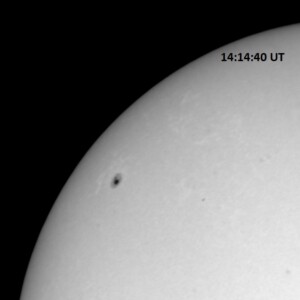 |
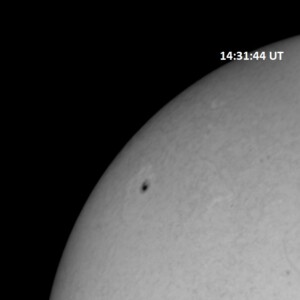 |
Solar activity is expected to remain low with only a slight chance of an M-class flare through 6 April.
April 3, 2024
Solar activity continues to be very low. The large spot first noted yesterday as a notch in the solar limb rotated into view and became AR 13628. AR 13624 and 13626 became more well defined. AR 13627 and an unnumbered, single, tiny spot make a total of five spots visible on the solar disk.
The first image is a white-light image taken with a SeeStar S50 telescope. The second is a red continuum image and the third is an H-alpha image, The second image is a 0.25 second exposure and third images is a 0.5 second exposure, each covering 13.8’x13.8′ on the Sun. The second and third images were recorded at the time indicated and are oriented so that celestial north is up, west is right in each image. Solar north is rotated 26 degrees clockwise in these images.
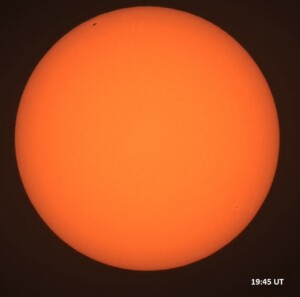 Full disk white light image showing the overall solar disk. Full disk white light image showing the overall solar disk. |
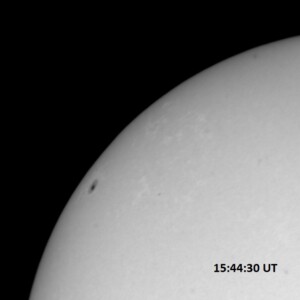 Detail of northeast disk highlighting AR 13628. Detail of northeast disk highlighting AR 13628. |
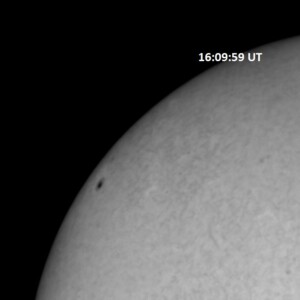 H-alpha image of the same part of the Sun. H-alpha image of the same part of the Sun. |
Solar activity is expected to be low, with a slight chance for M-class flares through 5 April.
April 2, 2024
After a “final” M3 class flare on 1 April peaking at 1:30 UT, the Sun had become totally quiet. The X-ray background fluctuated around the B9/C1 level the rest of 1 April, then dropped below C1 late on 1 April and continued a gradual decline that continues to this writing. Currently the X-ray background is at the B4 level and solar activity is characterized as very low. AR 13625, which grew and became active over the weekend, has rotated out of view. New region AR 13627 was observed today and is pictured below; it was the only visible spot on the solar disk.
Upon closer inspection another, much larger spot complex is JUST STARTING to make itself visible on the solar limb and will rotate into better view over the next two days. This should lift solar activity back to “low” levels and perhaps return a few flares to the daily solar routine.
The first image is a white light full-disk solar image taken afocally through a small telescope showing the lack of features on today’s Sun. The second image, also a full disk image, was taken yesterday on Mars by the Perseverance Rover. This image (from Spaceweather.com) shows the large spot groups that graced the Earth-facing side of the Sun two weeks ago. AR 13615 is still as large and complex as ever (but no farside CME’s have been reported so it may be in a quiet phase).
The bottom two images are today’s PVSO images, the bottom left image is the red continuum image of the northeast solar disk. The large active region about to appear (arrowed) shows as a “dent” in the solar limb. the second image (lower right) is the H-alpha image of the same part of the Sun. Each of the two PVSO images are 0.5 second exposures recorded at the time indicated on each. Each PVSO image covers 13.8’x13.8′ on the sky and is oriented so that celestial north is up, west is right in each image. Solar north is rotated 26 degrees right or clockwise with respect the celestial north in each image.
Solar activity is expected to be low with a slight chance for M-class flares through 4 April.
March 28, 2024
Solar activity increased to high levels early today as AR 13615 produced an M7.1/1N flare at 6:29 UT. This region remains the largest and most complex region visible on the solar disk , covering an area of 960 millionths of a solar hemisphere. This flare did not generate a CME, but a C8.4 flare from this same region at 9:43 UTC today did generate a CME. The remaining regions, all on the western half of the solar disk (except for tiny AR 13620) are small, simple and mainly quiet. AR has been the source of all the flare activity so far today, including another M-class flare, an M6.1/1N at 15:56 UT, and a C8.4/SF at 17:07 UT today. Observations began after 18:00 UT this afternoon. AR 13615 produced an M1.1 flare at 19:31 UT and an X1.1/3B at 20:56 UT. Both events were observed in their entirety during this afternoon’s observing session.
The first image is a red continuum image; the second image is an H-alpha image, each image a 0.5 second exposure covering 13.8’x13.8′ on the Sun. The images were recorded at the time indicated and are oriented so that celestial north is up, west is right in each image. Solar north is rotated 25.9 degrees clockwise in these images.
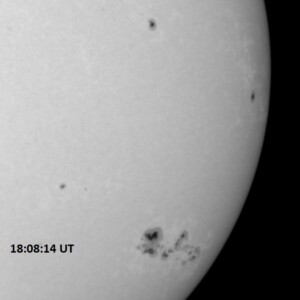 |
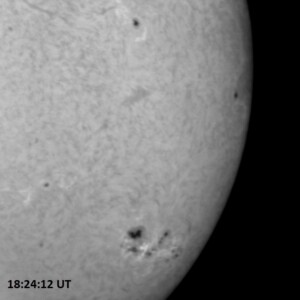 |
Solar activity is expected continue to be moderate to high, with the chance for an X-class flare, primarily due to AR 13615, through 29 March. This region rotates over the western limb on 30 March, decreasing probabilities to just a chance for M-class flares.
March 27, 2024
The sun’s activity reached high levels yesterday due to the large number of M-class flares. Five of these came from AR 13615, the largest of which was an M1.9 at 13:30 UT on 26 March. This region continues to be the largest, most complex region on the visible solar disk and was responsible for the majority of the activity. This region was the source for numerous C-class and optical sub-flares today, plus two M1.1 flares at 1:44 and 6:41 UT today. Since the second M-flare there had been no further M-class flares through at least 23:30 UT today. AR 13615 is showing signs of decay, however, so its flare potential may be decreasing as it rotates closer to the western limb. The four other spotted active regions were mostly stable.
A filament erupted just north of AR 13620 yesterday at 14:05 UT. We were observing at that time but the focus was on AR 13615. The filament generated a CME which may graze the Earth’s magnetic field early on 31 March.
The first image is a white-light image taken afocally through a 11.4 cm reflector. The second is a red continuum image and the third is an H-alpha image, The second and third images are each a 0.5 second exposure covering 13.8’x13.8′ on the Sun. The images were recorded at the time indicated and are oriented so that celestial north is up, west is right in each image. Solar north is rotated 25.6 degrees clockwise in these images.
Solar activity is expected to continue to be moderate, with a chance for X-class flares through 29 March due mainly to the flare potential of AR 13615.
March 26, 2024
The Sun continued at moderate levels of activity today, with four M-class flares produced by AR 13615 between 0:36 and 13:46 UT today, 26 March. The largest of these was an M1.8 at 0:36 UT today. The string of M-flares ended just as we opened for the observing session this morning and only C-class flares have occurred occasionally through 21:50 UT today. Shortly after that, AR 13615 produced an M1.6 flare that peaked at 21:58 UI (after we stopped observations for the day). This region has begun to decay, but remains the largest on the visible disk. The remaining spotted groups, quite small in comparison, were stable and quiet. The emerging flux of spots noted yesterday afternoon just south and west of AR 13615 had decayed completely by this morning.
The first image is a red continuum image; the second image is an H-alpha image, each image a 0.5 second exposure covering 13.8’x14.6′ on the Sun. The images were recorded at the time indicated and are oriented so that celestial north is up, west is right in each image. Solar north is rotated 25.6 degrees clockwise in these images.
Solar activity is expected to be moderate with M-class flares likely and a chance for X-class flares through 28 March. AR 13615 has the potential to produce large flares during this time.
March 25, 2024
Solar activity was at moderate levels due to M-class flares from AR 13615. The largest event in the last 24 hours or so was an M4.4/SB that occurred at 6:44 UT this morning, 25 March. At around 1:30 UT on 23 March, AR 13614 and 13615 combined to produce an X1.1 flare, which was the result of a pair of sympathetic solar flares from these regions. AR 13614 started with a larger flare, which triggered a smaller flare in 13615. This came from the likelihood that the two active regions were connected by a bundle of magnetic field loops, which resulted in a long duration X1.1 flare, complete with a CME that impacted yesterday (24 March) producing major G4 level geomagnetic storms. Since this event, there had been a lot of M-class flares over the weekend, at least 21 from 4:40 UT 23 March to 13:35 UT, 24 March. Since then, the activity subsided, the waning activity interrupted by the afore-mentioned M4 flare event.
AR 13615 was the largest region with an estimated area of 1130 millionths of a solar hemisphere. AR 13619 grew slightly, and the rest of the spotted active regions were either stable or in decay. There were a total of seven spotted active regions with a possible new region emerging near S19 W32, just southwest of AR 13915. This has not yet been confirmed.
The first image is a red continuum image; the second image is an H-alpha image, each image a 0.5 second exposure covering 13.8’x17.1′ on the Sun. The images were recorded at the time indicated and are oriented so that celestial north is up, west is right in each image. Solar north is rotated 25.6 degrees clockwise in these images.
Solar activity is expected to be moderate with M-class flares likely and a chance for X-class flares through 27 March. AR 13615 has the potential to produce large flares during this time.
March 22, 2024
The Sun was at low activity levels until this afternoon’s M4 / SN flare, which coincided with our short observing session. This flare came from AR 13615 which is the most active and complex region on the visible solar disk, responsible for an M7 flare at 7:36 UT on 20 March. It was the source of two more M-class flares and many C-class flares, including a C5.9 that happened at 20:12 UT today, only 20 minutes before the peak of the M4.2 that was observed this afternoon (our observations started one minute prior to the X-ray peak of the M4, then continued through its decay). AR’s 13618 and 13619 gradually developed, with the remaining active regions either stable or in slow decay.
The first image is a red continuum image covering 13.8’x13.8′ on the solar disk; the second image is an H-alpha image focused on AR 13615, covering 12.1’x13.8′ on the Sun. The images, each a 0.5 second exposure, were recorded at the time indicated and are oriented so that celestial north is up, west is right in each image.
Solar activity is expected to be low with an increasing chance for M-class flares through 24 March.
———————————————————————————————————————————
March 8, 2024
Solar activity continues to be low. AR 13599 is the largest, most complex active region on the visible solar disk, covering 140 MSH and sporting a complex ‘beta-gamma-delta’ magnetic configuration. The region has decayed a bit but is still producing nearly all of the flares over the last two days. The largest of these was a C6.7 at 12:07 UT on 7 March. Only a few low level C-class flares since until an M1.3 occurred at 21:26 UT from AR 13599. This just pushed solar activity back into the moderate range and is the first M-class flare in more than a week. All the other regions were unremarkable. All of them are located within the central region of the Sun’s disk and can fit in a single frame as shown below.
This will be the last observing session until at least 18 March (likely longer) due to Spring Break and other factors.
The first image is a red continuum image of five active regions (labeled); the second image is an H-alpha image of the same region. The images, each a 0.5 second exposure, were recorded at the time indicated on each; Each image covers 18.0’x13.8′ on the sky and is oriented so that celestial north is up, west is right in each image. Solar north is rotated 23 degrees right or clockwise with respect the celestial north in each image.
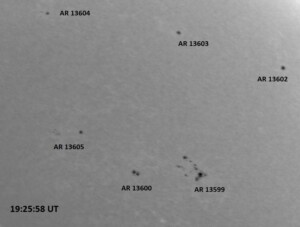 The six visible spotted regions are recorded in one frame on the sky. The six visible spotted regions are recorded in one frame on the sky. |
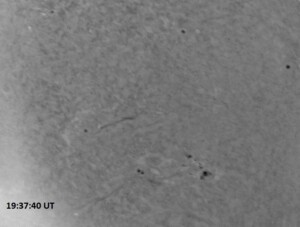 A few filaments are added to the scene in this H-alpha view. The glow at lower left is an ongoing issue with the CCD chip. A few filaments are added to the scene in this H-alpha view. The glow at lower left is an ongoing issue with the CCD chip. |
Solar activity is expected to be low with an increasing chance for M-class flares through 10 March.
March 6, 2024
Solar activity remains low, with only a few low-level C-class flares occurring both yesterday and today. AR 13599 and 13604 showed some growth, while the other four regions were either stable or in decay. AR 13595 has rotated out of view, and AR 13591 is nearing the western limb of the Sun and will be out of visibility in another day or so. A filament erupted in the southeast quadrant of the disk yesterday, this produced a coronal mass ejection.
The first image is a red continuum image of five active regions (labeled); the second image is an H-alpha image of the same region. The images, each a 0.5 second exposure, were recorded at the time indicated on each; Each image covers 18.0’x13.8′ on the sky and is oriented so that celestial north is up, west is right in each image. Solar north is rotated 22.8 degrees right or clockwise with respect the celestial north in each image.
Solar activity is expected to be low with a slight chance for M-class flares through 8 March.
March 5, 2024
Low solar activity continues with seven small spotted regions currently on the visible solar disk. C-class flares came from AR’s 13595, 13598, 13599, 13600, and 13602. AR’s 13598 and 13595 continue to decay as they exit the visible disk. Today was completely quiet with only a few C1 flares after 1400 UT today. There was a C2.6 from AR 13598 at 11:25 UT, the largest today so far.
The first column below displays the red continuum images (each 0.5 second exposure) and the second column the H-alpha images (each a 0.5 second exposure). The images were recorded at the time indicated on each; Each image covers 13.8’x13.8′ on the sky and is oriented so that celestial north is up, west is right in each image. Solar north is rotated 22.5 degrees right or clockwise with respect the celestial north in each image.
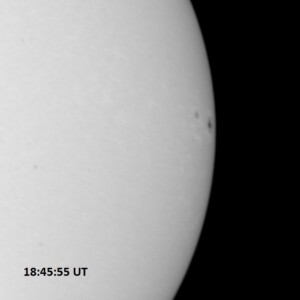 AR 13595 about to rotate out of view. AR 13595 about to rotate out of view. |
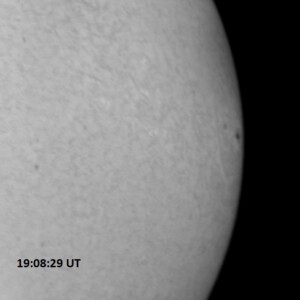 Same view in H-alpha. Same view in H-alpha. |
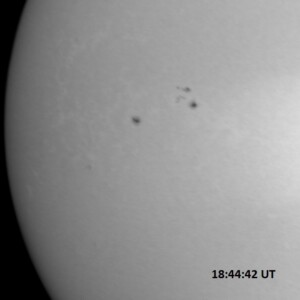 AR 13599 (“stacked” spots, right) and 13600 (single spot, left). AR 13599 (“stacked” spots, right) and 13600 (single spot, left). |
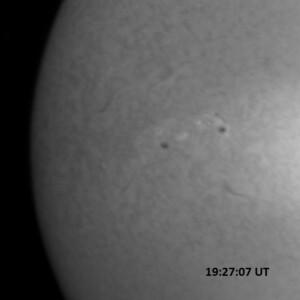 AR 13600 and 13599 plus a filament or two. AR 13600 and 13599 plus a filament or two. |
Solar activity is expected to be low with a slight chance for M-class flares through 7 March.
March 4, 2024
Solar activity has been low for five days now. The last M-class flare was the long-duration event that peaked at 18:50 UT on 28 February. Since then the largest event was a C6.6 on 2 March at 12:50. More recently, low-level C-class flares occurred from AR 13598, 13599, and 13602. ARs 13595 and 13598 each continue to decay as they are about to rotate over the western limb. The remaining regions were mainly quiet and unremarkable.
The first column below displays the red continuum images (each 0.5 second exposure) and the second column the H-alpha images (each a 0.5 second exposure). The images were recorded at the time indicated on each; Each image covers 13.8’x13.8′ on the sky and is oriented so that celestial north is up, west is right in each image. Solar north is rotated 22.5 degrees right or clockwise with respect the celestial north in each image.
Solar activity is expected to be low with a chance for M-class flares through 5 March, decreasing to a slight chance on 6 March.
March 1, 2024
Solar activity remains low. AR 13590 produced most of the C-class flare activity over the last two days. It maintains a complex structure as it prepares to rotate out of view. AR 13595 and 13598 are becoming more complex and grew in size and sunspot count. The other regions were quiet and stable.
The first image is a red continuum image of the western disk of the Sun; the second image is an H-alpha image of the same region. The images, each a 0.5 second exposure, were recorded at the time indicated on each; Each image covers 13.8’x13.8′ on the sky and is oriented so that celestial north is up, west is right in each image. Solar north is rotated 21 degrees right or clockwise with respect the celestial north in each image.
Solar activity is expected to be low with a chance for M-class flares through 3 March and a slight chance for an X-class flare through 2 March.
February 28, 2024
After several days of inactivity, AR 13590 finally produced a notable flare event. This was a “slow motion”, long duration M1.5 flare that started around 16:55 UT, peaked near 18:54 UT and ended around 23:00 UT. This is the firs M-class flare in three days, during which time this region was expected to produce M-class flares and possibly one or two more X-class flare. The region did begin flaring again, four C-class events prior to the M1 flare. Low level C-class flares also came from AR 13594, 13595, and 13596. AR 13595 is growing steadily and is beginning to take on more complex gamma magnetic field configurations. A C5.1/SF flare came from a spotless region east of AR 13592. A filament erupted and produced a CME, which was observed off the south center solar disk by SOHO at 11:00 UT on 27 February.
Aside from AR 13590 and 13595, all the other four spotted active regions were unremarkable. Another, unnumbered spotted region emerged near N7E20, east of AR 13594. All the spot regions form a distinct “T” shape across the solar disk.
The first column below displays the red continuum images (each 0.5 second exposure) and the second column the H-alpha images (each a 0.5 second exposure). The images were recorded at the time indicated on each; Each image covers 13.8’x13.8′ on the sky (except where indicated otherwise) and is oriented so that celestial north is up, west is right in each image. Solar north is rotated 21 degrees right or clockwise with respect the celestial north in each image.
Solar activity is expected to be low with a chance for M-class flares and a slight chance for an X-class flare through 1 March.
February 27, 2024
https://www.swpc.noaa.gov/news/sunspot-region-3590-evolution-february-19-27th on the evolution of AR 13590.
Solar activity is now at low levels. AR 13590 provided the largest flare over the last day with a C3.4 at 7:42 UT this morning. This would be the last recorded flare that this region produced from then to this writing (0:15 UT, 28 February). Other regions produced optical subflares: AR 13591, 13595, and 13596. AR 13595 produced the most of any region today, including a C1.5 at 14:35 UT and a C1.7 at 20:00 today (not observed since the focus was on AR 13590 today).
The first column below displays the red continuum images (each 0.1 second exposure) and the second column the H-alpha images (each a 0.5 second exposure). The images were recorded at the time indicated on each; Each image covers 13.8’x13.8′ on the sky and is oriented so that celestial north is up, west is right in each image. Solar north is rotated 21 degrees right or clockwise with respect the celestial north in each image.
Solar activity is expected to be low with a chance for M-class flares and a slight chance for an X-class flare through 29 February.
February 26, 2024
Solar activity was moderate yesterday with a single M2.0/1N flare from AR 13590. This region has grown to 1450 MSH, the largest of the current solar cycle. Since this M-class event yesterday, there have been no further events through 22:45 UT 26 February. The largest since the M2 flare was a C3.6 flare, which has not yet been listed in the event log. The other five numbered active regions were unremarkable.
Each image was taken at the time indicated; each was a 0.5 second exposure and is cropped to 13.8’x13.8′ in size. Celestial north is up, west is right in each image (Solar north is rotated 20.7 degrees clockwise from celestial north. The first image is a red continuum, taken through a thin sheet of cirrostratus. The remaining H-alpha images were taken through relatively clear skies.
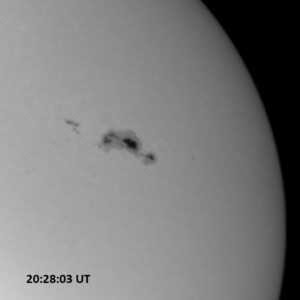 |
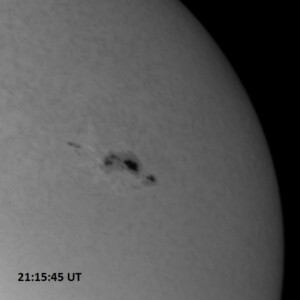 |
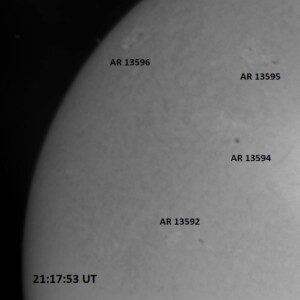 |
Solar activity is expected to stay moderate , with M-class flares still likely, and a chance for X-class flare activity, through 28 February.
February 24, 2024
AR 13590 continues to grow and dominate the visible solar hemisphere. Solar activity was high, with seven M-class flares since yesterday, two of which happened earlier today. The largest of these was an M4.5 at 6:34 UT today. There was also an M3.6 at 11:19 UT today. This would be the last M-class flare for today. We conducted a short follow-up observing session this afternoon to document the ongoing development of AR 13590, which is pictured in 3 of the 4 images below.
Three of the four images below are continuum images. The first is a wide field view of AR 13590. The second, immediately right of it is a closeup of the region. The third, immediately below the first, is a view of AR 13590 in H-alpha. Finally, the fourth is an image o the three active regions (top to bottom) AR 13594, 13592, and 13591. Each are 0.5 second exposures and are oriented so that celestial north is up, west is right. The white spots in the images are artifacts from the image processing.
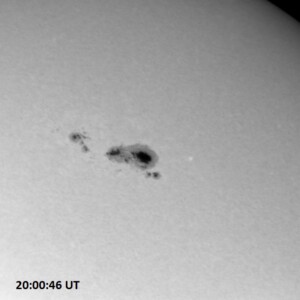 |
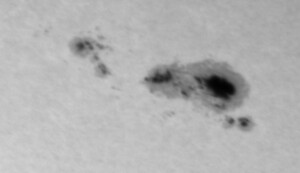 |
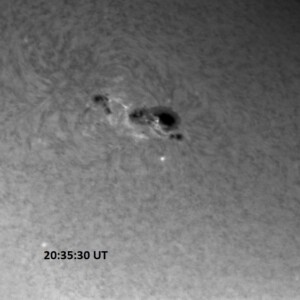 |
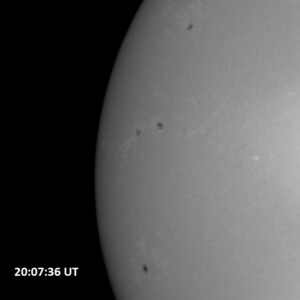 |
Solar activity is expected to remain at moderate levels with M-class flares likely and a chance of X-class flares through 26 February 2024.
February 23, 2024
Solar activity today retreated back to moderate levels. As of 23:45 UT on 23 February, there have been no further X-flares from AR 13590. Interestingly, none of the three X-flares from AR 13590 have produced coronal mass ejections. The region remains large and magnetically complex and has the potential for more strong flare production. AR 13594 produced 3 M-class flares: an M1.0 at 13:28 UT today; an M1.4 at 15:53 UT; and the largest of the three, an M2.6/1N at 17:47 UT. The image below was obtained as part of a series that documented the development of this flare from start to finish. It was recorded between the optical peak of 17:43 UT and the X-ray peak of 17:47 UT. The region also produced a number of C-class flares, one of which (a C5) was observed at PVSO.
Five new sunspot groups appeared since yesterday, bringing the total to seven, five of which are numbered. Two are tiny groups near the west limb, and three are small groups that just rotated over the east limb. One of these, AR 13591, produced an M1.5 flare at 0:14 UT on 22 February.
The first column below displays the red continuum images (each 0.1 second exposure) and the second column the H-alpha images (each a 0.5 second exposure). The images were recorded at the time indicated on each; Each image covers 13.8’x13.8′ on the sky and is oriented so that celestial north is up, west is right in each image. Solar north is rotated 20 degrees right or clockwise with respect the celestial north in each image.
Solar activity is expected to be high through 25 February with M-class flares likely and a chance for X-class flares.
February 22, 2024
Solar activity reached high levels with a pair of X flares from AR 13590 at 23:07 UT on 21 Feb and again at 6:32 UT on 22 Feb. Today it produced an M4.8 flare which peaked at 20:46 UT (shown in the bottom left image below). This was followed shortly by an X6.3/3B event which peaked at 22:34 UT. Both events were observed in their entirety at the PVSO. In fact, the X6 was the largest flare of the current solar cycle and the largest flare ever observed at PVSO! The bronze colored image below is from the Solar Dynamics Observatory in extreme UV. Former region AR 13575 is just beginning to rotate into view and it has a history of large flares, it may contribute to the activity in coming days.
The first image displays a red continuum image of AR 13590; the rest of the images are in H-alpha. Each image is a 0.5 second exposure, with the time indicated on each. Each image covers 13.8’x13.8′ on the sky and is oriented so that celestial north is up, west is right in each image. Solar north is rotated 19 degrees right or clockwise with respect the celestial north in each image.
Solar activity is expected to be high through 25 February with M-class flares likely and a chance for X-class flares from AR 13590 and possibly from the returning AR 13575.
February 21, 2024
Even with a growing and complex sunspot group AR 13590 (area of 760 MSH), solar activity remained low with only regular low-level C-class flares today. Another region, AR 13586 (90 MSH), is simple and stable and AR 13584 is difficult to distinguish as it decays.
But at 23:07 UT today, AR 13590 produced an X1.8 flare. This happened after we had closed for the day so we did not image this event. The below image was from the Solar Dynamics Observatory satellite, and the flare is the bright spot in the upper left part of the disk.
The first column below displays the red continuum images (each 0.1 second exposure) and the second column the H-alpha images (each a 0.5 second exposure). The images were recorded at the time indicated on each; Each image covers 13.8’x13.8′ on the sky and is oriented so that celestial north is up, west is right in each image. Solar north is rotated 18.8 degrees right or clockwise with respect the celestial north in each image.
Solar activity is expected to be low with a chance for M-class flares through 23 February.
February 20, 2024
There continues to be low solar activity with no M-flares observed anywhere through at least 21:05 UT, 20 February. AR 13583 produced a few C-class flares as it rotated out of view. AR 13590 is the largest on the visible disk, covering 530 MSH; AR 13586 is second with an area of 160 MSH. AR 13583 had an area of 170 MSH but it just rotated out of visibility. AR 13590 produced the largest flare of the last two days, a C5.7 at 12:47 UT yesterday. The other three spotted active regions were quite unremarkable. A c2.8 flare was observed by our solar observatory to have originated at AR 13584; this event peaked at 15:56 UT. We observed the tail end of another event: a C2.7 flare from AR 13590, peaking at 17:12 UT. Other than these events, the sun remains very quiet.
The first image displays a red continuum image of AR 13590; the rest of the images are in H-alpha. Each image is a 0.5 second exposure, with the time indicated on each. Each image covers 13.8’x13.8′ on the sky and is oriented so that celestial north is up, west is right in each image. Solar north is rotated 19 degrees right or clockwise with respect the celestial north in each image.
Solar activity is expected to be low with a chance for M-class flares through 22 February.
February 19, 2024
AR 13576 rotated over the southwestern limb of the Sun three days ago and as it did so, it produced an X2.5 flare at 6:53 UT on 16 February. This was followed by an M2.9 at 22:10 UT on the same date. Since that last M-class flare, there has been no further M- or X-class activity up until this writing (21:37 UTC 19 February). Most of the currently visible sunspot groups are small and quiet. Yesterday, C-class activity came from AR 13576 (from beyond the western limb), 13583, and 13590. The latter AR is rotating into view on the ENE limb and it appears to be a large region. The largest flares today were a C6.7 at 9:40 UT today from AR 13590, and a C5.7 at 12:47 UT today, also from AR 13590. AR 13683 contributed two flares today: a C1.9 at 1:47 UT, and a C2.6, at 6:40 UT today. Solar activity continued to be low, with few low-level C-class flares, through the rest of today, through 21:37 UT
The first column below displays the red continuum images, and the second column the H-alpha images, each a 0.5 second exposure. The images were recorded at the time indicated on each; Each image covers 13.8’x13.8′ on the sky and is oriented so that celestial north is up, west is right in each image. Solar north is rotated 18.8 degrees right or clockwise with respect the celestial north in each image.
Solar activity is expected to be low with a chance for M-class flares through 21 February.
February 14, 2024
AR 13582 produced an M1.0 flare at 3:10 UT today, followed by an M1.0 flare at 7:35 UT today. Since then, these regions, along with AR 13584, produced quite a few C-class flares, the largest of which was a C7.5 at 17:56 UT today (image of the flare captured through thin cirrus appears immediately below, 13.8’x13.8′ in size on the sky).
AR 13483 continues to grow in size overall, but it had seen some decay in the middle part. A new spot is rotating into view on the NE limb of the Sun. The remaining active regions were quiet and unremarkable. There are currently eight spotted regions on the visible solar disk, six of which are numbered. The largest of these continues to be AR 13576, with an area of 600 Millionths of a Solar Hemisphere (MSH). Second and third place are AR’s 13583 and 13582, with areas of 270 and 240 MSH respectively. The remaining regions were 50 MSH or smaller each.
The first image is a red continuum of most of the active regions currently visible on the Sun; it is a 0.5 second exposure. The second image is an H-alpha image of the same region, also a 0.5 second exposure. Both are recorded at the time indicated on the image, cover 13.8’x18.0′ on the sky, and are oriented so that celestial north is up, west is right (solar north is rotated 16.5 degrees counterclockwise/right of celestial north).
Solar activity is likely to reach moderate levels, with a slight chance for X-class flares through 16 February.
February 13, 2024
Ever since the long duration M2.6 flare from a hidden active region over the NE limb, the Sun has been quiet, with only a C4.9/SF flare from AR 13583 at 1:38 UT today. An unspecified source produced a C5.0 at 7:59 UT today. This is the largest flare today through 21:00 UTC 13 February. AR’s 13582 and 13583 continued a slower pace of growth while AR 13576 appeared to have decayed some (but still maintains a complex magnetic configuration). This region was the target of a day long flare watch today at PVSO. All the other regions on the Sun were quiet and inactive. The AR over the NE limb has not yet revealed itself.
The first image is a red continuum of most of the active regions currently visible on the Sun; it is a 0.5 second exposure. The second image is an H-alpha image of the same region, also a 0.5 second exposure. Both are recorded at the time indicated on the image, cover 13.8’x17.1′ on the sky, and are oriented so that celestial north is up, west is right (solar north is rotated 16.5 degrees counterclockwise/right of celestial north).
Solar activity is likely to reach moderate levels from time to time, with a slight chance for X-class flares through 15 February.
February 12, 2024
The Sun remains rather active, with mid-to high-level M-class flares occurring nearly every day. AT 13:10 UT on 9 February, AR 13575, which had rotated over the limb a day earlier, produced an X3.3 flare. AR 13576 had been the source of many M-class flares, mostly low level, but one was almost an X-class: an M9.0 at 23:07 UT on 10 February. This was followed by an impulsive M6.5/2B at 3:48 UT on 12 February. This region also produced a C6.9 flare at 5:54 UT, 12 February. An active region just beyond the NE limb produced an M1.0 flare at 22:45 UT on 11 February. Since the last observing session, AR 13582 and 13583 emerged on the visible solar disk (only two days ago they first appeared) and grew rapidly. AR 13576 did show some decay.
Today, AR 13583 and 13576 were the only two active regions to generate solar flares, with an M1.1 coming from AR 13576 at 13:08 and an M1.4/1F coming from the same region at 15:48 UT. When the weather cleared and the seeing settled to allow observations at PVSO to resume (around 20:00 UT) these regions had quieted down considerably. There continued to be activity on the northeast limb, however, that we followed. This was the source of a long-duration M2.6 flare that peaked at 21:17 UT.
The first image is a red continuum of most of the active regions currently visible on the Sun; it is a 0.25 second exposure. The second image is an H-alpha image of the same region, a 0.5 second exposure. Both are recorded at the time indicated on the image, cover 13.8’x18.0′ on the sky, and are oriented so that celestial north is up, west is right (solar north is rotated 16.5 degrees counterclockwise/right of celestial north).
Solar activity is likely to reach moderate levels from time to time, with a slight chance for X-class flares through 14 February.
February 7, 2024
The Sun once again achieved high levels of activity overnight with a M1.3 flare at 18:49 UT on 6 February and a long duration M5.1/SF at 3:31 UT on 7 February, both from AR 13575. This flare produced a coronal mass ejection that was observed five minutes after the peak of the M5 flare. A SOHO GIF sequence of the CME is shown below (click to animate).
AR 13575 is in decay but still maintains enough magnetic complexity (referred to as a “delta” configuration) to produce further flares. AR 13576 maintains its complexity but is decreasing in areal coverage, now down to 540 MSH from over 700 two days ago. AR 13571 is the third largest spot group on the disk (110 MSH, after 13575’s 250 MSH) but has been completely quiet. All the other spotted and numbered active regions (a total of 10 visible) are quiet and stable.
The first column within the table below displays the red continuum images, and the second column the H-alpha images, each a 0.5 second exposure. The images were recorded at the time indicated on each; the images of AR 13575 cover 13.8’x13.8′ on the sky, and the images of AR 13576 cover 15.9’x13.8′ on the sky. All five are oriented so that celestial north is up, west is right in each image. Solar north is rotated 14 degrees right or clockwise with respect the celestial north in each image.
The below image shows the M1 flare observed today about two minutes prior to its X-ray peak flux. It was a rather long-duration event and the most powerful so far since last night’s M5.1 (through 23:05 UTC, 7 February).
It is likely that solar activity will continue at moderate levels with occasional M-class flares and a chance for an isolated X-class flare through 8 February. AR 13575 has begun to rotate over the SW limb, and as it is carried further and further out of view by solar rotation, the flare probabilities will decrease to a chance for M-class flares and a slight chance for X-class flares on 9 February and possibly afterwards.
February 6, 2024
Solar activity continued at moderate levels with an M2.2 at 2:28 UT today and a long duration M4.2 flare peaking at 3:12 UT today. Both of these were from AR 13575, and both of these flares generated CMEs. Slight decay and some separation occured in the smaller leader spots of AR 13575. The same occurred in the trailing spots of 13576. Both continue to be the largest (AR 13575 is 270 MSH and AR 13576 is 610 MSH) and most complex sunspot groups visible on the solar disk. The other spots were small, quiet, unremarkable.
We monitored AR 13576 the entire day, but the region only produced C-class and optical subflares. The largest during our session was a C6.2 at 18:35 UT. A C5.1 and C6.2 also occurred during our session, then everything quieted down after the M1.3 that came from AR 13575. We are only able to monitor one of these regions so we did not observe this flare.
The first column below displays the red continuum images, and the second column the H-alpha images, each a 0.5 second exposure. The images were recorded at the time indicated on each; Each image in the top row covers 13.8’x13.8′ on the sky, and each in the bottom row cover 18.0’x13.8′ on the sky, and are oriented so that celestial north is up, west is right in each image. Solar north is rotated 14 degrees right or clockwise with respect the celestial north in each image.
Solar activity is likely to continue at moderate to high levels, with occasional M-class flares and a chance for an isolated X-class flare through 7 February. The chance for X-class flares decrease on 8 February as AR 13575 rotates over the SW limb.
February 5, 2024
Two large active regions are now visible on the Sun. AR 13575 developed late last week and has grown in size and complexity. AR 13576 was observed on Mars last week by the Perseverance rover and has rotated into view three days ago. Both have increased the probability of M-class flares occurring. Over a 12 hour period from 12UT 4 Feb until 12UT 5 Feb there were over a dozen M-class flares, mostly from AR 13576. The largest of these was an M2.7 at 22:37 UT on 4 February. The region continued to produce most of today’s flares, including two M flares within two hours of each other and many C-flares.
This image (click for animation) shows the development of AR 13576 (lower left part of the Sun’s disk). AR 13575 is in the lower right part of the Sun’s disk. AR 13575 covers 350 millionths of a solar hemisphere (MSH) while 13576 covers twice as much area, 700 MSH. The other six spotted regions were unremarkable.
The first column below displays the red continuum images, 0.25 second exposures; and the second column shows the H-alpha images, each of these a 0.5 second exposure. The images were recorded at the time indicated on each; Each image covers 13.8’x13.8′ on the sky and are oriented so that celestial north is up, west is right in each image. Solar north is rotated 14 degrees right or clockwise with respect the celestial north in each image.
Solar activity is likely to reach moderate to high levels, with M-class flares expected and an increased chance for X-class flares through 7 February. This is due to the flare potentials of AR 13575 and 13576.
February 1, 2024
Solar activity remains at low levels today with only C-class flare activity. AR’s 13571 and 13567 were the only two named regions which produced C-class flares, the largest of which (so far, as of 21:00 UT on 1 Feb.) was a C3.0 from an unspecified location. More regions continue to rotate into view or emerge on the eastern half of the disk, and these are shown below, with the numbered regions labeled. The C3 event was a long-duration event from a region of enhanced flux near the solar meridian. This region produced a coronal mass ejection which is Earth-bound and due to arrive late on
The first column below displays the red continuum image, and the second column the H-alpha image, each a 0.5 second exposure. The images were recorded at the time indicated on each and are oriented so that celestial north is up, west is right in each image. Solar north is rotated 12 degrees right or clockwise with respect the celestial north in each image.
Solar activity is likely to remain low the next three days, but (primarily) AR 13567 (along with other regions) will keep a chance of M-flares in place through 3 February.
January 31, 2024
The Sun continued at low activity levels with only C-class flares yesterday and today. The largest of these was yesterday’s C5 event that came from AR 13559, which had just rotated out of view. AR 13567 is currently the largest and most complex active region on the visible disk and was the source of a C4.5 at 8:29 UT today, the second largest since yesterday. Today there are nine spot groups on the visible disk of the Sun (four have emerged or rotated into view since yesterday) but only five of these are currently numbered. All of these were unremarkable today.
The first column below displays the red continuum images, and the second column the H-alpha images, each a 0.5 second exposure. The images were recorded at the time indicated on each; Each image covers 13.8’x13.8′ on the sky and are oriented so that celestial north is up, west is right in each image. Solar north is rotated 12 degrees right or clockwise with respect the celestial north in each image.
Solar activity is likely to remain low the next three days, but (primarily) AR 13567 will keep an elevated chance of M-flares in place through 2 February.
January 30, 2024
Solar activity remains low after yesterday’s brief surge of activity overnight. There were only occasional C-flares. AR 13559 has rotated out of view. AR 13566 emerged a day or so ago and was numbered, and the larger region rotating into view was also numbered as AR 13567. There were two simple spots visible but were not numbered yet. A total of five spotted active regions are visible on the solar disk.
The first column below displays the red continuum images, and the second column the H-alpha images, each a 0.5 second exposure. The images were recorded at the time indicated on each; Each image covers 13.8’x13.8′ on the sky and are oriented so that celestial north is up, west is right in each image. Solar north is rotated 11 degrees right or clockwise with respect the celestial north in each image.
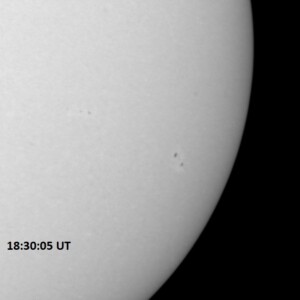 |
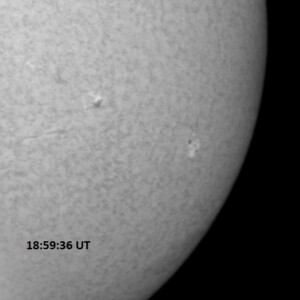 |
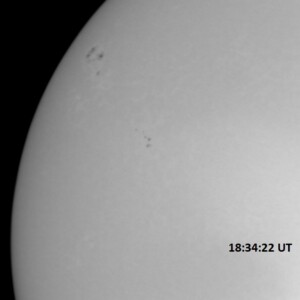 |
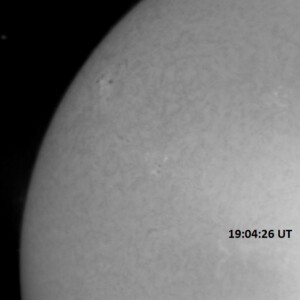 |
Solar activity is expected to be low, with a chance for M-class flares though 1 February.
January 29, 2024
The extended period of weather unfavorable for observation was largely the cause of a 10 day hiatus in solar observations. Last week saw a period which included 13 M-class flares over a 1.5 day period, from late 22 January to early 24 January. Nearly all of these were from AR 13561. After one more M-class flare late 24 January, the activity subsided to include only C-class flares (two of which were nearly M-class early on 27 January), which became less frequent and lower in magnitude. The silence was interrupted early this morning by a pair of M-class flares from departing region AR 13559. The first was an M1.2/SF at 1:40 UT and an M6.7 at 4:38 UT, which generated a solar particle event that is ongoing as of this writing (22:45 UT 29 January).
The number of sunspots has decreased since last week as the active longitudes rotate over the western limb of the sun. Only five numbered ARs are currently visible, plus three no-name groups or individual spots. One of the numbered regions is rotating over the limb and two more have nearly lost their spots. Since a C5.9 that was observed in AR 13559 this morning at the observatory, the x-ray flux background has nearly flatlined at the C1 level, through this writing.
The first column below displays the red continuum images, and the second column the H-alpha images, each a 0.5 second exposure. The images were recorded at the time indicated on each; Each image covers 13.8’x13.8′ on the sky and are oriented so that celestial north is up, west is right in each image. Solar north is rotated 11 degrees right or clockwise with respect the celestial north in each image.
Solar activity is expected to be low, with a chance for M-class flares from now through 31 January. There was an increasing chance for M-flares today, 29 January, due to AR 13559, but those chances decrease as the region rotates over the limb.
January 19, 2024
Solar activity continued to be low, with only low-level C-class flare activity. AR 13559 has grown some, and a new flux or bundle of magnetic fields has emerged southwest of AR 13555. The rest of the 11 numbered regions were either stable or in decay.
The first column below displays the red continuum images, and the second column the H-alpha images, each a 0.5 second exposure. The images were recorded at the time indicated on each; The top two images each cover 13.8’x18.0′ on the sky, and the second row images each cover 13.8’x13.8 in apparent size. Celestial north is up, west is right in each image.
Solar activity is expected to be low, with a chance for M-class flares from now through 21 January.
January 18, 2024
The Sun is maintaining an extended period of low activity. This is the 7th day in a row with low activity and no M-class flares. The largest flare of the last six days was a C9.5 that happened at 12:06 UT on 14 January. More recently the larges flare recently was a C5 that happened at 4:08 UT on 18 January and came from AR 13553. Despite the large number of sunspot groups (9 as of this afternoon’s count), there has not been any significant activity.
The first column below displays the red continuum images, and the second column the H-alpha images, each a 0.5 second exposure. The images were recorded at the time indicated on each, and each cover 13.8’x13.8 in apparent size, except where indicated otherwise. Celestial north is up, west is right in each image.
Solar activity is expected to be low, with a chance for M-class flares through 20 January.
January 12, 2024
Solar activity remained at moderate levels with four low-level M-class flares. The largest of these was an M1.5 at 17:52 UT on 11 January, from AR 13539. This region became stable and also produced several C-class flares. AR13540 and 13547 were stable and inactive; AR 13541 decayed some, and new regions 13548 and 13549 were inactive as well.
The first column below displays the red continuum images, and the second column the H-alpha images, each a 0.5 second exposure. The images were recorded at the time indicated on each, and each cover 13.8’x13.8 in apparent size. Celestial north is up, west is right in each image.
Solar activity is expected to be mainly at low levels with a chance of M-class flares through 14 January.
January 11, 2024
Solar activity reached and remained at moderate levels yesterday into today, with an AR from just beyond the SE limb producing an M1.1 flare at 12:55 UT on 10 January. That region has rotated into view today. AR 13538 was the source of an M1.7 flare at 23:28 UT on 10 January. AR 13538 produced an M1.3 flare today at 12:51 UT, and an M1.2 flare today at 19:23 UT (while clouds were delaying our opening for today’s observations). AR 13539 produced an M1.5 flare at 17:52 UT. AR 13538 was also the source of some high-level C-class flares today.
AR continues to grow as it approaches the western limb but it it about to rotate out of view in another day or so. AR 13539, following 13538 toward the western limb, also grew and developed some; this was the source of C-clas flares. The remaining regions (ten now visible, plus three un-numbered regions that emerged onto the disk and a fourth, yet to be numbered, rotated into view) were mainly quiet and stable. Filaments continue to launch off the Sun: one started to do so quickly at 20:28 UT yesterday, on the east limb of the Sun, this produced a C5.6 flare that peaked at 20:41 UT on 10 January; another filament was observed to lift off at 5:30 UT on 11 January.
The first column below displays the red continuum images, each a 0.5 second exposure. The second column includes the H-alpha images, each 1.0 second exposure. The images were recorded at the time indicated on each, and cover the size noted in the caption. Celestial north is up, west is right in each image.
Solar activity is expected to at low levels with an ongoing chance of M-class flares through 13 January.
January 10, 2024
Solar activity continues to be low, with only minor C-class flares occurring. The two largest in the last two days, so far (as of 21:25 UT, 10 Jan.) was a C9.6 at 3:25 UTC today from AR 13538, and an M1.4 at 12:55 UT today, from an unspecified location. Today, the C-flares have been coming from AR’s 13538 (5 events, the most of any region today), 13536 (one event this afternoon), 13540 (one optical sub-flare) and 13546 (two events). There are a total of 11 numbered spotted active regions on the visible solar disk today, but only 10 of them were observed this morning during the daily sunspot counts. AR’s 13538 and 13539 are slowly growing, as is AR 13546, with the rest of these spot groups either stable or in decay.
Filaments continue to lift off the Sun: one just beyond the SE limb and the other (around 45 degrees long) just south of AR 13541. Both started doing so just after 14:00 UTC. An eruptive prominence, in the shape of a tall loop, was observed from PVSO at 21:14. This feature had faded almost entirely by 21:18 UT.
The first column displays the red continuum images of each of the visible spotted active regions on the solar disk. Each of these images is a 0.5 second exposure. The second column displays H-alpha line centered images of the same zones on the Sun depicted by the continuum images. Each of these is 1.0 second exposure. Each image covers 13.8’x13.8′ on the sun and has celestial north up, west right (solar north is rotated two degrees clockwise from celestial north).
Solar activity is expected to be low, with a continuing chance for M-class flares from now through 12 January.
January 9, 2024
AR 13536 rotated into view on December 31 and produced an X5.0/3B flare at 21:49 UT, the largest of the current solar cycle. Since then, it had rotated into better view and generated several more M-class flares before quieting down. The most recent M-class flare was a M3.9 that occurred at 1:56 UT on 4 January. Since this event, there had been no further M-class flares (all C-class) up until the time of this posting (20:00 UT 9 January). The largest event in the past two days was a C5.7 that happened at 15:50 UT on 8 January from AR 13538. This region is growing some, in contrast with AR 13536, which is slowly decaying. AR’s 13539, 13542, and 13544 were quiet and stable; AR 13540 decayed some; ARs 13541 and 13543 grew slightly; and AR 13545 rotated into view. Another group, soon-to-be numbered AR 13546, emerged east of the 13540/13541 pair.
Another event of note was an erupting filament, which began to liftoff near the southeast limb at 17:00 UTC on 8 January. This 24 degree long filament the produced a Coronal Mass Ejection, which was first seen by SOHO LASCO satellite imagery at 00:48 UT on 9 January.
Four individual images are displayed below, with two copies of each of the continuum image. Each of the images is a 0.5 second exposure. The first column contains the continuum images of the east and west solar disk, showing all the visible spotted active regions currently on the solar disk. The second/middle column are the same images as the left column, but with the active regions/sunspot groups labeled. The right most column includes the H-alpha line center images of each zone on the Sun. The UT of image acquisition is provided in one corner of each image. Each frame covers 13.8’x13.8′ on the sky and is oriented so that celestial north is up, west is right. Solar north is offset from celestial north by two degrees to the right.
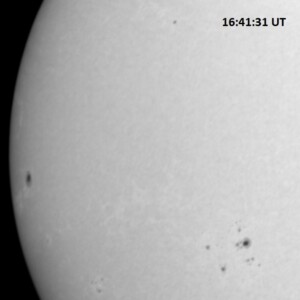 |
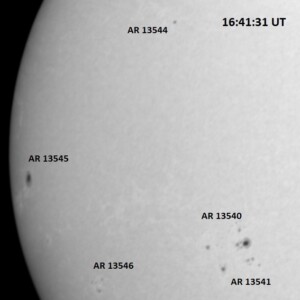 |
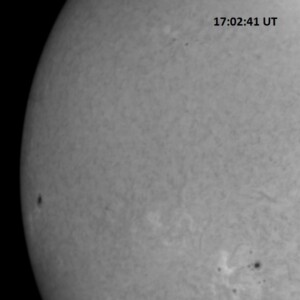 |
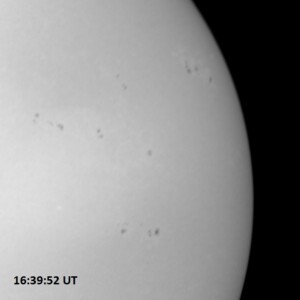 |
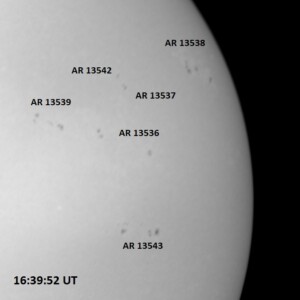 |
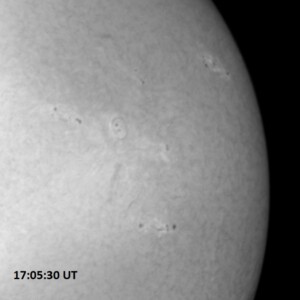 |
Solar activity is expected to be at low levels, with a chance for M-class flares and a slight chance for X-class flares through 11 January.
==========================================================

